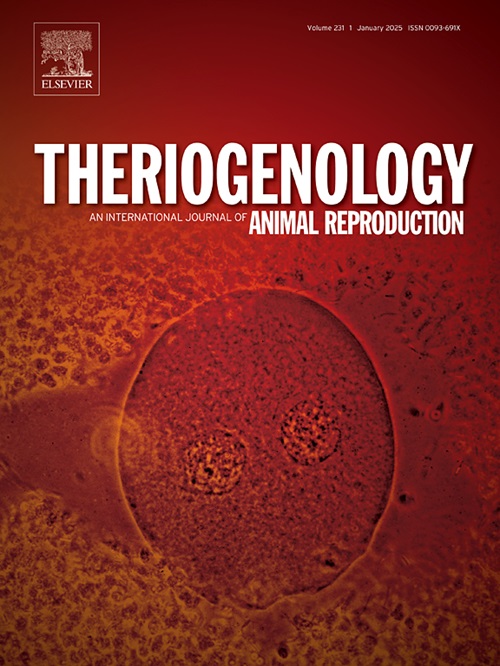Influence of genotype-environment interaction on stress parameters during spontaneous farrowing in modern and traditional pig breeds housed in crates and pens
IF 2.4
2区 农林科学
Q3 REPRODUCTIVE BIOLOGY
引用次数: 0
Abstract
The transition from farrowing crates to farrowing pens aims to improve animal welfare by enabling the expression of maternal behavioural profiles. This study examines the spontaneous farrowing process in both farrowing crates and pens for modern German Landrace (GL) and traditional German Saddleback (GS) pigs — two breeds with different breeding histories and adaptations to housing systems. The goal is to investigate whether, and how, both breeds benefit equally from farrowing pens. From the birth of the first piglet until 1 h after the last delivery (intrapartum; ip), half-hourly blood samples were collected from catheterized sows in addition to blood samples retrieved from antepartum (ap) and postpartum (pp) periods. After spontaneous, non-induced farrowing, the traditional GS breed exhibited a significantly shorter gestation length, smaller litter weight, and a lower incidence of labour dystocia compared to modern GL sows. Breed effects were observed for profiles of heart rate (ip: GL > GS), cortisol (ap: GL < GS; ip: GL < GS), adrenaline (ap: GL < GS), noradrenaline (ip: GL < GS), non-esterified fatty acids (ap: GL < GS; ip: GL < GS), glucose (ap: GL > GS), and β-hydroxybutyrate (ap: GL < GS) at distinct peripartum periods. Effects due to housing appeared for heart rate (ap: crate > pen) as well as respiratory rate (crate < pen) and adrenaline (crate > pen) at distinct time points. Taken together, breed-specific endocrine control and energy-related metabolic properties might suggest a need for tailored housing conditions during parturition for modern and traditional sows.
基因型-环境相互作用对现代和传统猪种在板条箱和围栏中自然分娩应激参数的影响
从产仔箱到产仔栏的过渡旨在通过使母体行为特征的表达来改善动物福利。本研究考察了现代德国长白猪(GL)和传统德国马鞍背猪(GS)在产仔箱和产仔栏中的自发分娩过程,这两个品种具有不同的育种历史和对住房系统的适应。目的是调查两个品种是否以及如何从产房中获得同样的好处。从第一只仔猪出生到最后一次分娩后1小时(产时;在产前(ap)和产后(pp)采集血液样本的同时,还采集了导管母猪半小时的血液样本。在自然、非诱导分娩后,与现代GL母猪相比,传统GS品种的妊娠期明显缩短,产仔重量更小,难产发生率更低。观察了品种对心率曲线(ip: GL >;GS)、皮质醇(ap: GL <;GS;ip: GL <;GS),肾上腺素(ap: GL <;GS),去甲肾上腺素(ip: GL <;GS),非酯化脂肪酸(ap: GL <;GS;ip: GL <;GS)、葡萄糖(ap: GL >;GS)和β-羟基丁酸酯(ap: GL <;GS)在不同的围产期。房屋对心率的影响(ap: crate >;钢笔)以及呼吸频率(板条箱<;钢笔)和肾上腺素(箱子>;钢笔)在不同的时间点。综上所述,品种特有的内分泌控制和能量相关的代谢特性可能表明,现代和传统母猪在分娩期间需要量身定制的住房条件。
本文章由计算机程序翻译,如有差异,请以英文原文为准。
求助全文
约1分钟内获得全文
求助全文
来源期刊

Theriogenology
农林科学-生殖生物学
CiteScore
5.50
自引率
14.30%
发文量
387
审稿时长
72 days
期刊介绍:
Theriogenology provides an international forum for researchers, clinicians, and industry professionals in animal reproductive biology. This acclaimed journal publishes articles on a wide range of topics in reproductive and developmental biology, of domestic mammal, avian, and aquatic species as well as wild species which are the object of veterinary care in research or conservation programs.
 求助内容:
求助内容: 应助结果提醒方式:
应助结果提醒方式:


